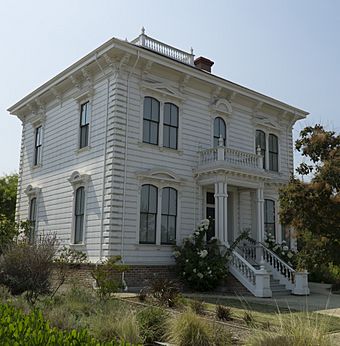Forest Home Farms facts for kids
Quick facts for kids |
|
|
Forest Home Farms
|
|

The David Glass House
|
|
| Location | 19953 San Ramon Valley Blvd., San Ramon, California |
|---|---|
| Built | 1850 |
| Architect | Rider & Connor |
| Architectural style | Colonial, Italianate |
| NRHP reference No. | 02000677 |
| Added to NRHP | June 28, 2002 |
Forest Home Farms is a special historic park in San Ramon, California. It covers 16 acres (about 6.5 hectares) and is open to everyone. This park was once a working farm.
In 1997, a generous woman named Ruth Quayle Boone gave the land and all its buildings to the City of San Ramon. She wanted it to be a park and a historical site. It was first a memorial to her husband, Travis Moore Boone. After Ruth passed away in 1998 at 94, the park also honored her. It recognized her kindness and the important role women played in farming in the San Ramon Valley.
Contents
Exploring Forest Home Farms
This 16-acre farm sits at the bottom of the Dougherty Hills. A stream called Oak Creek flows through it, dividing it into two nearly equal parts. The northern part of the farm holds most of the buildings used by the Boone family. These include two houses, 14 smaller farm buildings, and two decorative garden structures called pergolas.
The Boone House
The Boone House is a large, 22-room home. It was built around 1900 in a style called Dutch Colonial. This means it has a unique roof shape and design. The house has been updated many times over the years. Today, it is used for offices, meetings, and fun recreation programs.
Farm Buildings and History
The farm has 14 other buildings that are all different sizes and ages. One barn was built a very long time ago, between 1850 and 1860. There's also a huge building, about 7,000 square feet (650 square meters), for storing farm equipment and cars. You can also see a three-building plant that was used for processing walnuts. This included a tall, three-story building for hulling (removing the outer shell) and drying the nuts.
The David Glass House
The southern part of the park is home to the David Glass House. This house is built in the Victorian style and dates back to the late 1860s or early 1870s. It was moved here from another farm called Lora Nita Farm. The Glass House has two stories and is made of wood. It also has a smaller back section that might be even older than the main house.
Next to the Glass House is a two-story wooden structure called a tankhouse. It was used to hold a water tank. The outside of the Glass House has been carefully restored to look like it did originally. The area around the house was also redesigned to match an old photo from the 1890s. A windmill from the Henry Farm was placed behind the house to complete this historical look.
Visiting the Park Today
Forest Home Farms Historic Park is open to the public from Monday to Friday, 10:00 AM to 4:00 PM. You can take a self-guided tour using the Otocast app on your phone.
The park also offers two special educational programs. These are called Farm Life Education and Victorian Life Education. They were created for third-grade students but can be enjoyed by kids from second to fifth grade. During the COVID-19 pandemic, the Farm Life Education Program became available online. This allowed teachers and students to learn about farm life from their homes. The park also hosts many group tours and free Saturday programs when there are no restrictions.
Looking Ahead at the Park
Since opening as a historic park, many exciting projects have been completed. The David Glass House was fully restored and is now a historic home museum. The old barn from the 1850s was also fixed up. It is now used as a new learning space for the educational programs. The city continues to work on preserving the park's history. Many projects are planned to keep these old buildings strong for many more years.
See also



